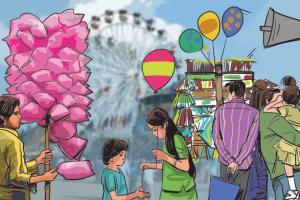The mela's haphazard structure with an incredible mix of stalls, set in a field, its edges open, as well as its transient nature, mirrors life, which is why we find it so exhilarating and overwhelming

Illustration/Uday Mohite
![]()
Last week, I went to a mela after a long time.
The word mela calls up filmi images—ferris wheels, gypsy women, palmists, bangle sellers and of course, crowds whose main role is to part siblings for life, or the length of a movie, whichever feels longer. As a child, the mela feels thrilling and frightening. The terror - of the crowds separating you from parents, the thrill - from sensory overload of candy floss and fried food, joyrides, games of marksmanship (ring the object, shoot the balloon), the self-congratulatory rhymes of tombola announcements “two fat ladies need to lose weight, eight and eight, eighty eight”, mixing with the inevitable declaration that “a child has been found whose name is Dolly, Dolly ke parents please collect her from the announcement booth” while Dolly cried in the background.
The idea of getting lost in a mela is echoed in many songs about ‘duniya ka mela’ or bazaar. The world is like a fair, unpredictable, dazzling but maybe dangerous, for a ladki akeli could get carried away yaniki transgress. The mela’s haphazard structure with an incredible mix of stalls and choices – familiar and unknown - its open edges, as well as its transient nature, mirrors life, but at 10x, which is why we find it so exhilarating and overwhelming.
Old-style melas were linked to the rhythms of nature, happening usually around harvest season, or to the feasts of saints—whether it’s the Mahim Urs or the Mount Mary fair (where I once got my picture taken in a photo studio, sitting on a crescent moon, looking simply dreamy in a t-shirt with two tortoises on it). They link communities through shared rituals.
The best one I ever went to was in Lahore, at the Data Sahib Urs of its patron saint. My host, horrified at the idea of slumming it, took some persuading. Once he reluctantly agreed, his cook and driver also decided to come along, in golden jootis and embroidered caps. Together, we listened to qawwalis, then browsed midnight stalls eating a gigantic malpuha called aflatoon. I acquired a locket but was prevented from getting a cheap tattoo on my arm (PV hearts SRK). The purposelessness of the activities was their purpose.
Old style melas make well-heeled urban types squeamish, sweat and germs, yaniki the mixture of classes. Diverse spaces are increasingly perceived as uncomfortable and unpalatable.
In comparison, new age melas aka flea markets feel more streamlined and sanitised. Linked to the rhythms of consumption they appear around the season of gift-giving. Organised in rows and clusters, they are fun in their way, manageable but predictable. The same floral hair clips, unoriginal Bollywood kitsch, unstructured muslin garments and minimalist trinkets from Hipsterville. Notably, they are expensive, which acts as a filter. The purposefulness of revenue models fills the air with some ennui. It is hard to get distracted in such a fair, much less lost.
The mela I went to last week managed to combine the pleasures of both though, and I returned with black masala, ragi papad, curative jadi-bootis (duly planted), a sari printed with emojis, a magical liniment, a tummy full of crab and fish fry and my future revealed by a tarot reader who has invented a tarot for desi situations. A little bit of past in the future, is always a nice present it seems.
Paromita Vohra is an award-winning Mumbai-based filmmaker, writer and curator working with fiction and non-fiction. Reach her at paromita.vohra@mid-day.com
Catch up on all the latest Crime, National, International and Hatke news here. Also download the new mid-day Android and iOS apps to get latest updates
 Subscribe today by clicking the link and stay updated with the latest news!" Click here!
Subscribe today by clicking the link and stay updated with the latest news!" Click here!







